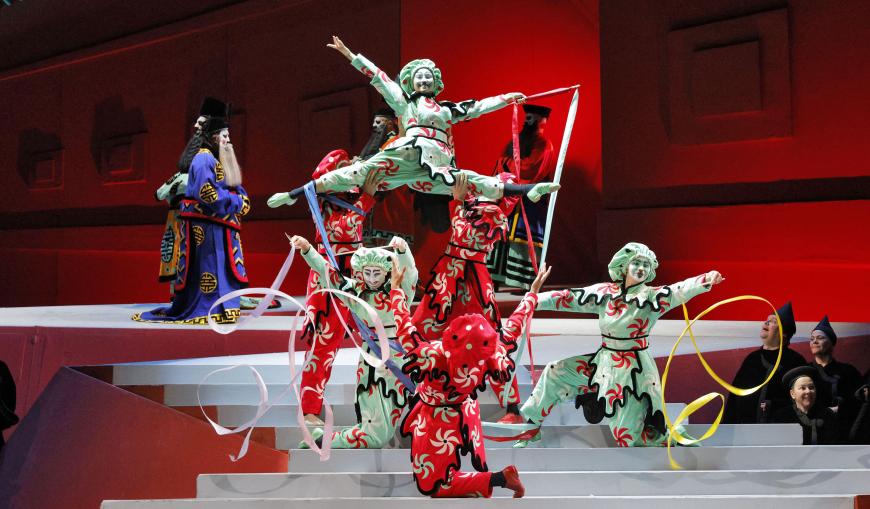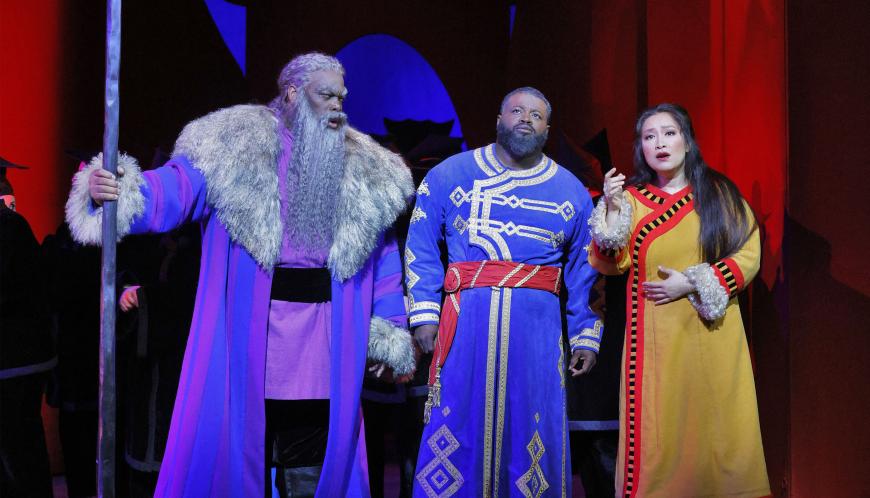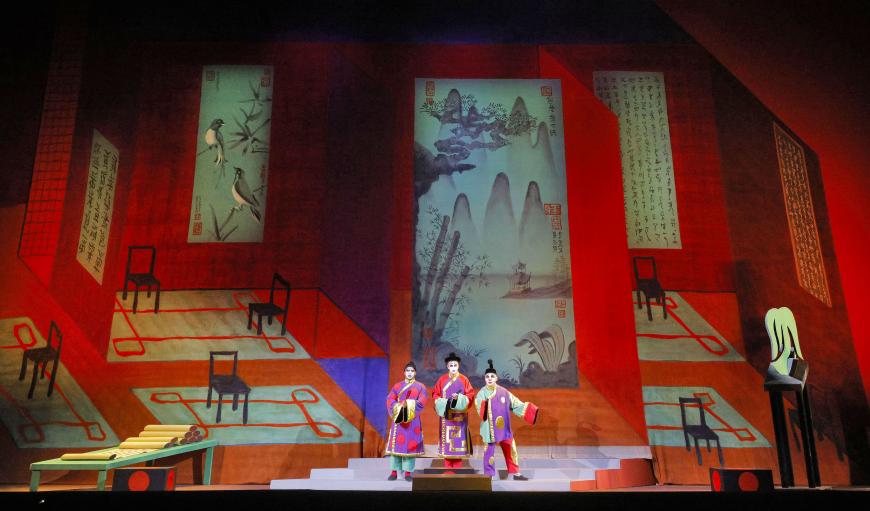
As sunrise approaches, Giacomo Puccini’s fairy-tale opera Turandot comes to its spectacular conclusion. Whether composer Franco Alfano’s finale is close to the one that Puccini would have created had he lived to complete the work is destined to remain one of opera’s unsolvable enigmas.
There is no doubt, however, that in the hands of British artist David Hockney, Puccini’s creation emerges as a fully realized masterwork. First presented by Lyric Opera of Chicago in 1992, Hockney’s production (with its spectacular accompanying costumes by Ian Falconer) was next presented by San Francisco Opera in 1993.
It’s taken 30 years, but on Saturday, a beautifully restored presentation of this production was performed by Los Angeles Opera at the Dorothy Chandler Pavilion. Conducted by James Conlon (who was celebrating his 200th performance of a Puccini opera), LA Opera’s production features an impressive cast led by soprano Angela Meade as Princess Turandot and tenor Russell Thomas as her lovestruck suitor, Prince Calaf. The volcanic nature of their confrontation is ideally balanced by the winsome presence and dulcet voice of Chinese soprano Guanqun Yu as the perfect Liù.

As a former resident of California and an ardent lover of opera, Hockney has maintained long-term relationships with both SF Opera and LA Opera. Combined, the two companies have presented Hockney’s interpretations of Igor Stravinsky’s The Rake’s Progress, Richard Wagner’s Tristan and Isolde, Mozart’s The Magic Flute, Richard Strauss’s Die Frau ohne Schatten, and Turandot.
Hockney once said, “I prefer living in color.” And if there is a signature to his opera designs, it is their dynamic fusion of color and form. At the same time, each design is directly related to its respective opera’s source material: William Hogarth’s paintings and engravings for The Rake’s Progress, Celtic motifs for Tristan, Masonic symbolism for The Magic Flute, Mughal art for Frau, and Chinese scroll painting (and architecture) for Turandot.
The current reincarnation of Hockney’s Turandot is brought vibrantly to life by the direction of Garnett Bruce and is accentuated by the choreography of Kitty McNamee, which features a cadre of gaily clad Chinese acrobats and lithe, falling water-sleeved dancers. The entire experience is a feast for the eyes and ears.
On the musical side, Conlon’s interpretation is insightful and dynamic, based on in-depth research and analysis, which he shares in preconcert lectures before every performance.

Without question, Meade strikes a formidable figure as Turandot, physically and vocally. The impact of her voice is palpable, capable of cutting through the full force of the orchestra like an executioner’s blade or projecting to the rafters like an artillery shell. The combined power Meade wields with Thomas is titanic.
Coming off impressive performances as Otello at LA Opera last season, Thomas is a worthy opponent as Calaf. His voice is abundantly resonant and rich in color. His high notes are impressive, if not always rock steady. But when the moment came for his star-turn aria — opera’s greatest hit, “Nessun dorma” — he definitely hit the mark.
Since her 2015 LA Opera debut as Rosina in John Corigliano’s The Ghosts of Versailles, Yu has been cast as a Mozart specialist, singing the Countess in The Marriage of Figaro, Vitellia in The Clemency of Titus, and Donna Anna in Don Giovanni. And while the role of Liù may not compare in scope, Yu’s immensely sympathetic and superbly sung performance is heartrending.
While the three Chinese courtiers — Ping, Pang, and Pong — are generally seen as commedia dell’arte-style comic caricatures, in this production they are anything but. Ryan Wolfe, Terrence Chin-Loy, and Julius Ahn bring a critical perspective to the drama as voices of reason in a world gone mad. Their Act 2 trio of nostalgia floats like an island in a stream, set off by Hockney’s spectacular Chinese screen-painting background.

Rounding out the cast are Morris Robinson, who brings his stentorian bass to the role of Timur, and tenor Ashley Faatoalia as the ancient Emperor. The immense chorus plays a resounding role, prepared by Jeremy Frank.
Overall, it was Conlon’s energized conducting that pulled all the pieces together. And as the final crescendo grew and grew, the mauve light of dawn transformed until the entire stage exploded in a blaze of Mandarin red. Life in color, indeed!
LA Opera’s production of Turandot runs through June 8.




